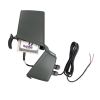Global Water RG600 Tipping Bucket Rain Gauge
Features
- Constructed of anodized aluminum
- Reliable, highly accurate, and simple to operate
- Rugged and long lasting
- Free ground shipping
- Expedited repair and warranty service
- Lifetime technical support
- More
Overview
The Global Water RG600 Tipping Bucket rain gauge is a durable weather instrument for monitoring rain rate and total rainfall. With minimal care, the tipping bucket will provide many years of service. All Global Water tipping buckets were designed by the National Weather Service to provide a low-investment, reliable, industrial, tipping bucket rain gauge.
Mechanics
Its simple design assures trouble-free operation, yet provides accurate rainfall measurements. The tipping bucket has an 8" orifice and is shipped complete with mounting brackets and 25 ft. of 2-conductor cable. The tipping bucket sensor mechanism activates a sealed reed switch that produces a contact closure for each 0.01" or 0.2 mm of rainfall. The tipping bucket rain gauge can be pole-mounted or bolted to a level plate.
- Capacity: Unlimited
- Accuracy: +/-1% at 1 inch per hour
- Average Switch Closure Time: 135 ms
- Maximum Bounce Settling Time: 0.75 ms
- Maximum Switch Rating: 30 VDC @ 2A, 115 VAC @ 1 A
- Operating Temperature: 32 to +123.8 F (0 to +51 C)
- Dimensions: 10.125" x 8" inch (26cm x 20cm)
- Shipping Weight: 8 lbs. (3.6 kg)
- Cable: 25 ft (7.6 m), 2 conductor
- (1) Tipping bucket rain gauge
- (1) Set of mounting brackets
- (1) 25 ft. length of 2-conductor cable
In The News
Desert Weather Extremes Create Plant Winners And Losers
Researchers at Arizona State University, studying in the Chihuahan desert of New Mexico, have made some interesting finds related to ecosystem “tipping points.” The term refers to the points at which areas are changed beyond what is typical for them, practically creating new ecosystems where some life forms dominate and others falter. The scientists approached the issue by setting up 50 different study plots in the desert. These were laid out within the Jornada Basin Long Term Ecological Research site and incorporated gear like tipping bucket rain gauges, data loggers and custom constructions that redirected and cut off water as needed for study treatments.
Read MoreStone Lab: Cyanobacteria Monitoring in Ohio Lakes
Microcystin, one of several toxins produced by the cyanobacteria that form harmful algal blooms (HABs), has become a popular topic of lake research as the human health impacts of HABs become better understood. Stone Lab is one of the leading groups in algal bloom research on Lake Erie and other lakes in Ohio. For more than 100 years, Stone Lab has conducted biology research and provided science education and outreach to the region. Over the years, thousands of individuals of varying ages have learned from the resources Stone Lab provides. Stone Lab’s Research Coordinator and Senior Researcher, Justin Chaffin, learned of Stone Lab while an undergraduate student at Bowling Green State University Fireland Campus.
Read MoreFrom Assessment to Angler: Continual Research Ensures Lake Erie Remains a Beacon of Freshwater Fishing
Lake Erie is well known for its abundant recreational fishing. Anglers come from across the country to try their luck at the “walleye capital of the world” and search for other freshwater species, such as bass, perch, and steelhead trout. As one of the world’s largest freshwater fisheries, much effort is made behind the scenes to maintain fishing opportunities for visitors to enjoy year after year, efforts that often go unnoticed by the public. One of the lake's most important economic and tourism centers is the city of Sandusky, home to the Sandusky Fisheries Research Station . As part of the Ohio Division of Wildlife, the unit serves as a base for assessing fish populations and managing harvest with partner agencies from around Lake Erie.
Read More











